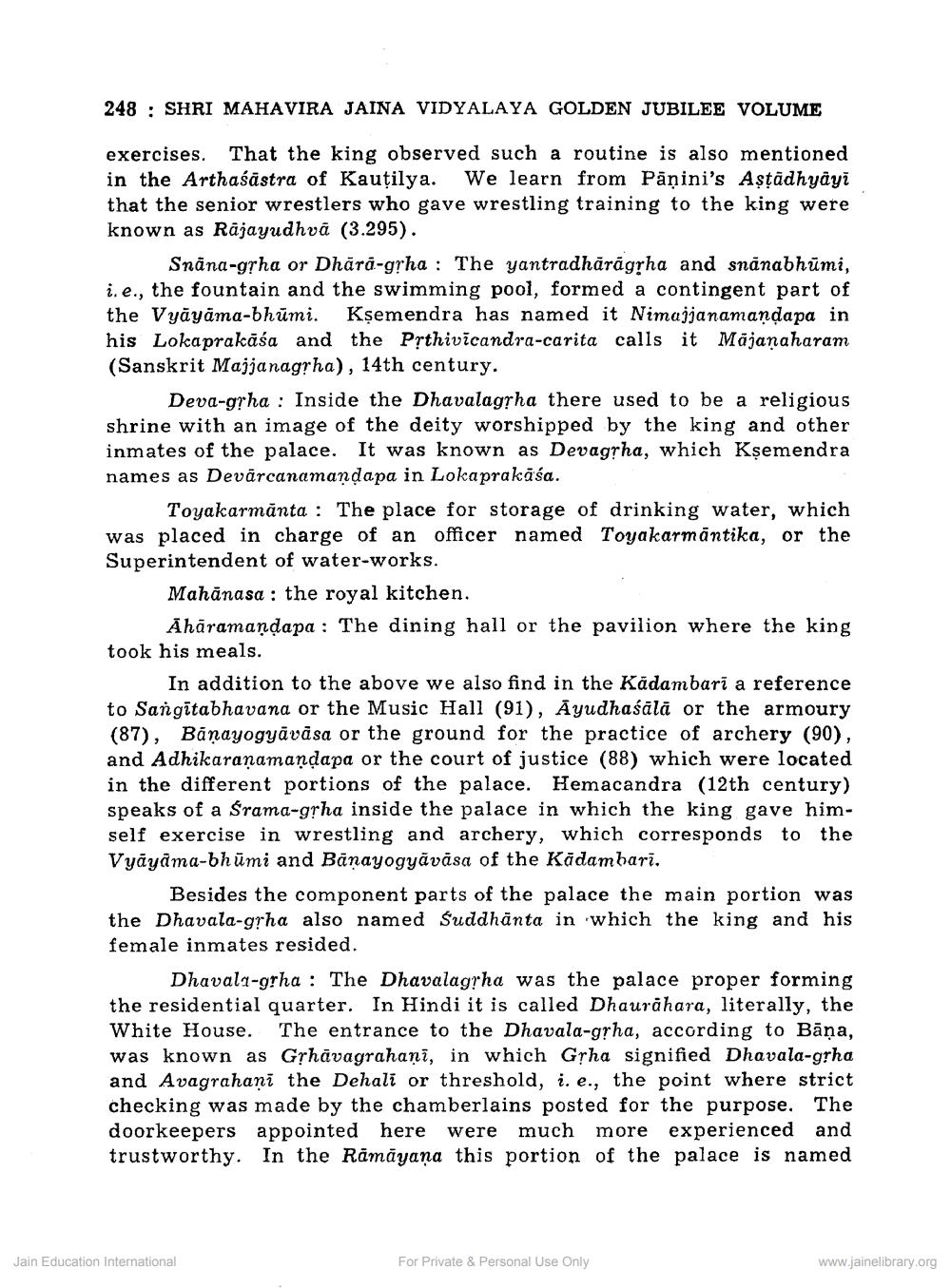Book Title: Ancient Indian Palace Architecture Author(s): V S Agarwala Publisher: Z_Mahavir_Jain_Vidyalay_Suvarna_Mahotsav_Granth_Part_1_012002.pdf and Mahavir_Jain_Vidyalay_Suvarna_ View full book textPage 7
________________ 248 SHRI MAHAVIRA JAINA VIDYALAYA GOLDEN JUBILEE VOLUME exercises. That the king observed such a routine is also mentioned in the Arthaśästra of Kautilya. We learn from Pāṇini's Aṣṭādhyāyi that the senior wrestlers who gave wrestling training to the king were known as Rajayudhvā (3.295). Snäna-gṛha or Dhara-gṛha: The yantradhārāgṛha and snanabhumi, i.e., the fountain and the swimming pool, formed a contingent part of the Vyāyāma-bhūmi. Kṣemendra has named it Nimajjanamanḍapa in his Lokaprakasa and the Prthivicandra-carita calls it Majanaharam (Sanskrit Majjanagṛha), 14th century. Deva-gṛha: Inside the Dhavalagṛha there used to be a religious shrine with an image of the deity worshipped by the king and other inmates of the palace. It was known as Devagṛha, which Kṣemendra names as Devârcanamaṇḍapa in Lokaprakasa. Toyakarmanta: The place for storage of drinking water, which was placed in charge of an officer named Toyakarmantika, or the Superintendent of water-works. Mahanasa: the royal kitchen. Aharamandapa: The dining hall or the pavilion where the king took his meals. In addition to the above we also find in the Kadambari a reference to Sangitabhavana or the Music Hall (91), Ayudhaśālā or the armoury (87), Banayogyāvāsa or the ground for the practice of archery (90), and Adhikaranamandapa or the court of justice (88) which were located in the different portions of the palace. Hemacandra (12th century) speaks of a Srama-gṛha inside the palace in which the king gave himself exercise in wrestling and archery, which corresponds to the Vyāyama-bhumi and Banayogyäväsa of the Kadambari. Besides the component parts of the palace the main portion was the Dhavala-gṛha also named Suddhanta in which the king and his female inmates resided. Dhavala-gṛha: The Dhavalagṛha was the palace proper forming the residential quarter. In Hindi it is called Dhaurahara, literally, the White House. The entrance to the Dhavala-gṛha, according to Bāṇa, was known as Grṛhavagrahani, in which Grha signified Dhavala-gṛha and Avagrahani the Dehali or threshold, i. e., the point where strict checking was made by the chamberlains posted for the purpose. The doorkeepers appointed here here were much more experienced and trustworthy. In the Rāmāyaṇa this portion of the palace is named Jain Education International For Private & Personal Use Only www.jainelibrary.orgPage Navigation
1 ... 5 6 7 8 9 10 11 12 13 14 15 16 17 18
